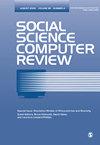Automated Detection of Media Bias Using Artificial Intelligence and Natural Language Processing: A Systematic Review
IF 2.7
2区 社会学
Q2 COMPUTER SCIENCE, INTERDISCIPLINARY APPLICATIONS
引用次数: 0
Abstract
Media bias has long been a subject of scholarly interest due to its potential to shape public perceptions and behaviors. This systematic review leverages advances in natural language processing (NLP) to explore automated methods to detect media bias, addressing five core questions: it examines the definitions and operationalization of media bias, explores the NLP tasks addressed for its detection, the technologies used, and their respective outcomes and applied findings. This review also examines the practical applications of these methodologies and assesses the patterns, implications, and limitations associated with using artificial intelligence for media bias detection. Analyzing peer-reviewed articles from 2019 to 2023, the review initially identified 519 articles, which ultimately included 28 relevant ones. Significant heterogeneity is observed in bias definitions, affecting the analysis and detection approaches. The review highlights the predominant use of some methods and identifies challenges such as inconsistencies in problem definition, outcome measurement, and comparative method evaluation. Regardless of the conceptualizations of bias and the methods used, studies consistently identify bias in media outlets. Thus, studying media bias remains necessary for raising awareness and detection, and NLP methods are significant allies in this endeavor. This research aims to consolidate the foundations of recent advances in NLP for bias detection, encouraging researchers to focus on developing transparent, task-specific tools and work toward a consensus on a technical definition of bias and standardized metrics for its evaluation.使用人工智能和自然语言处理的媒体偏见自动检测:系统综述
媒体偏见长期以来一直是学术界感兴趣的主题,因为它有可能塑造公众的看法和行为。这篇系统的综述利用自然语言处理(NLP)的进步来探索自动检测媒体偏见的方法,解决了五个核心问题:它检查了媒体偏见的定义和操作化,探讨了为检测媒体偏见而解决的NLP任务,使用的技术,以及它们各自的结果和应用发现。本综述还考察了这些方法的实际应用,并评估了使用人工智能进行媒体偏见检测的模式、含义和局限性。分析了2019年至2023年的同行评议文章,该综述最初确定了519篇文章,最终包括28篇相关文章。在偏差定义中观察到显著的异质性,影响分析和检测方法。这篇综述强调了一些方法的主要用途,并确定了挑战,如问题定义、结果测量和比较方法评估方面的不一致。无论偏见的概念和使用的方法如何,研究一致地确定了媒体渠道中的偏见。因此,研究媒体偏见对于提高意识和检测仍然是必要的,而NLP方法在这一努力中是重要的盟友。本研究旨在巩固NLP在偏见检测方面的最新进展基础,鼓励研究人员专注于开发透明的、特定于任务的工具,并努力就偏见的技术定义和评估的标准化指标达成共识。
本文章由计算机程序翻译,如有差异,请以英文原文为准。
求助全文
约1分钟内获得全文
求助全文
来源期刊

Social Science Computer Review
社会科学-计算机:跨学科应用
CiteScore
9.00
自引率
4.90%
发文量
95
审稿时长
>12 weeks
期刊介绍:
Unique Scope Social Science Computer Review is an interdisciplinary journal covering social science instructional and research applications of computing, as well as societal impacts of informational technology. Topics included: artificial intelligence, business, computational social science theory, computer-assisted survey research, computer-based qualitative analysis, computer simulation, economic modeling, electronic modeling, electronic publishing, geographic information systems, instrumentation and research tools, public administration, social impacts of computing and telecommunications, software evaluation, world-wide web resources for social scientists. Interdisciplinary Nature Because the Uses and impacts of computing are interdisciplinary, so is Social Science Computer Review. The journal is of direct relevance to scholars and scientists in a wide variety of disciplines. In its pages you''ll find work in the following areas: sociology, anthropology, political science, economics, psychology, computer literacy, computer applications, and methodology.
 求助内容:
求助内容: 应助结果提醒方式:
应助结果提醒方式:


